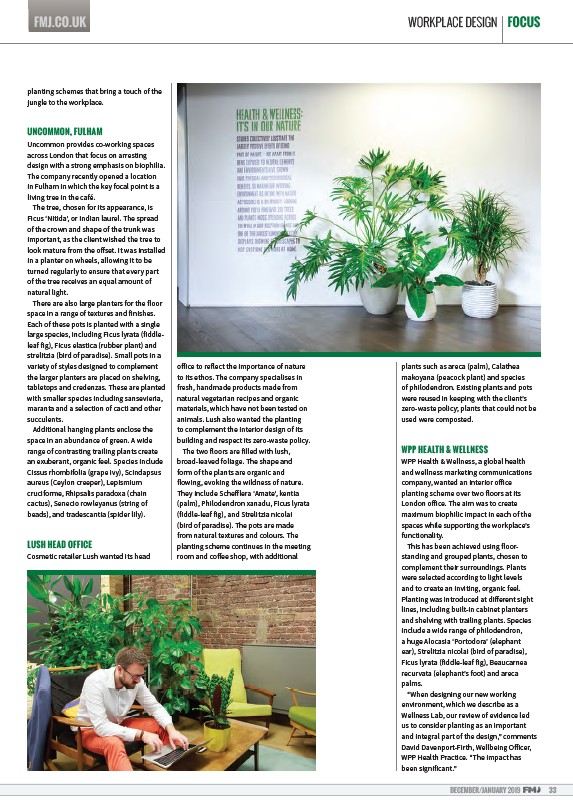
FMJ.CO.UK WORKPLACE DESIGN FOCUS
DECEMBER/JANUARY 2019 33
planting schemes that bring a touch of the
jungle to the workplace.
UNCOMMON, FULHAM
Uncommon provides co-working spaces
across London that focus on arresting
design with a strong emphasis on biophilia.
The company recently opened a location
in Fulham in which the key focal point is a
living tree in the café.
The tree, chosen for its appearance, is
Ficus ‘Nitida’, or Indian laurel. The spread
of the crown and shape of the trunk was
important, as the client wished the tree to
look mature from the o set. It was installed
in a planter on wheels, allowing it to be
turned regularly to ensure that every part
of the tree receives an equal amount of
natural light.
There are also large planters for the floor
space in a range of textures and finishes.
Each of these pots is planted with a single
large species, including Ficus lyrata (fiddleleaf
fig), Ficus elastica (rubber plant) and
strelitzia (bird of paradise). Small pots in a
variety of styles designed to complement
the larger planters are placed on shelving,
tabletops and credenzas. These are planted
with smaller species including sansevieria,
maranta and a selection of cacti and other
succulents.
Additional hanging plants enclose the
space in an abundance of green. A wide
range of contrasting trailing plants create
an exuberant, organic feel. Species include
Cissus rhombifolia (grape ivy), Scindapsus
aureus (Ceylon creeper), Lepismium
cruciforme, Rhipsalis paradoxa (chain
cactus), Senecio rowleyanus (string of
beads), and tradescantia (spider lily).
LUSH HEAD OFFICE
Cosmetic retailer Lush wanted its head
o ice to reflect the importance of nature
to its ethos. The company specialises in
fresh, handmade products made from
natural vegetarian recipes and organic
materials, which have not been tested on
animals. Lush also wanted the planting
to complement the interior design of its
building and respect its zero-waste policy.
The two floors are filled with lush,
broad-leaved foliage. The shape and
form of the plants are organic and
flowing, evoking the wildness of nature.
They include Sche lera ‘Amate’, kentia
(palm), Philodendron xanadu, Ficus lyrata
(fiddle-leaf fig), and Strelitzia nicolai
(bird of paradise). The pots are made
from natural textures and colours. The
planting scheme continues in the meeting
room and co ee shop, with additional
plants such as areca (palm), Calathea
makoyana (peacock plant) and species
of philodendron. Existing plants and pots
were reused in keeping with the client’s
zero-waste policy; plants that could not be
used were composted.
WPP HEALTH & WELLNESS
WPP Health & Wellness, a global health
and wellness marketing communications
company, wanted an interior o ice
planting scheme over two floors at its
London o ice. The aim was to create
maximum biophilic impact in each of the
spaces while supporting the workplace’s
functionality.
This has been achieved using floorstanding
and grouped plants, chosen to
complement their surroundings. Plants
were selected according to light levels
and to create an inviting, organic feel.
Planting was introduced at di erent sight
lines, including built-in cabinet planters
and shelving with trailing plants. Species
include a wide range of philodendron,
a huge Alocasia ‘Portodora’ (elephant
ear), Strelitzia nicolai (bird of paradise),
Ficus lyrata (fiddle-leaf fig), Beaucarnea
recurvata (elephant’s foot) and areca
palms.
“When designing our new working
environment, which we describe as a
Wellness Lab, our review of evidence led
us to consider planting as an important
and integral part of the design,” comments
David Davenport-Firth, Wellbeing O icer,
WPP Health Practice. “The impact has
been significant.”